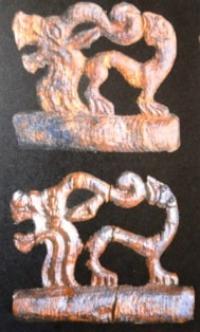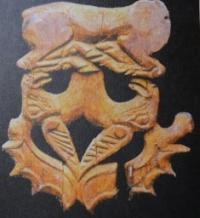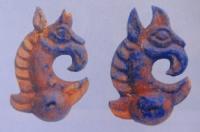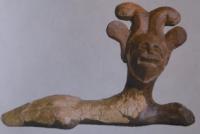You are here
Horse equipment on Berel barrow.





Skiing outing in near Ust-Kamenogorsk.
“Does progress mean that we dissolve our ancient myths? If we forget our legends, I fear that we shall close an important door to the imagination”
James Christensen.
Retail therapy in town Semey.
Thirteen horses accompanying the chief were killed with a blow of a hatchet in the forehead and stacked behind a wall of the chamber in two tiers. The bottom tier consisting of seven animals was separated from the top one with a thick layer of birch barks and bush, Kuril tea that has antiseptic properties.
The red saddle-horses are turned with their heads towards the rising sun, to the east. Due to the phenomenon of "frozen" graves, not only skin of animals, but also soft tissues and complete horse outfit remained unchanged.
Heads of four of the thirteen horses were fit in leather masks topped with wooden horns of mountain goats in full-scale. One of the masks was decorated probably with a wooden sculpture of tiger-gryphon – a fantastic and polymorphous animal with a body of a feline predator with a strong crooked beak and long spirally twirled horns made of leather.
The superbly decorated saddles found there are considered the most ancient in Kazakhstan as of today. A saddle covered with shaggy skin of a predator and a felt application on a saddle cover showing a scene of a gryphon tearing a hoofed animal are of special interest.
One of the horses had a shield attached to its saddle, which was made of wooden sticks. The horse outfit was decorated with multiple wooden items produced with the help of various methods combining the bas-relief and sculpture techniques.
All these items, plates, dendants and belt dividers were decorated only on the face side covered with a gold foil and tin while the reverse side was used to fasten them to the belts of horse harness. Art played a special role in the life of the ancient nomads.
It was not of decorative nature, and being based on an archaic and mythologised mind it was a unique sign text expressing a definite system of the society's values. The items of arms, horse outfit and those for sacred purpose were formed in the Scythian-Siberian animal style and reflect its warlike and aristocratic character.
According to the magic interactivity logic of the ancient people, the brightest, positive and distinctive qualities of depicted animals are transferred to carriers of these images. Therefore, it is not casual that the elite barrows of the Scythian-Sachs period including the "princely" burial places in Altai have revealed unique samples of the bright art of ancient nomads.
The scope of images eternised on accessories of horse outfit includes deer, lambs, birds, mountain rams and goats, feline predators – all are representatives of the local fauna. But a special place in the bestiary of ancient nomads was taken by the images of fantastic, syncretic and polymorphous creatures, invented animals that were never seen in nature.
These creatures, gryphons, combined features of different animals. They had a body of a feline predator with a long tail thrown on back, a beak of a predatory bird, a mane drawn in even height or in curbs and a horn with spirally twirled ends.
Probably, the images of gryphons concentrated those qualities of real animals that their creators wanted to emphasise. The scenes of animals’ fighting are one of the characteristic features of animal style. The finds with a similar plot take place in the Berel collection as well.
Plaques and pendants picture the scene of a feline predator attacking a deer or a mountain goat; a gryphon biting its tail; a double-dimension image of a hoofed animal’s head in a gryphon’s beak, representing a version of the scene of tearing in a smaller composition.
Semantics of the tearing scene is treated as struggle of the good and malicious elements, light and dark, as a "cosmogonical act of creation through destruction", as revival to a new life, as a symbol of eternal movement and eternal conflict of opposites.
Dynamics and expressiveness in the scenes of fighting animals is most often demonstrated through turn of bodies by 180o; through emphasising of strained muscles by marks such as points, brackets and commas; through stressing of characteristic features, like exaggerated image of horns.
Predators often had hungry grin of jaws and powerful sharp-clawed paws. The favourite methods of composition construction were the principles of mirror symmetry and heraldic development. The plots worked out in this way can often be seen on belt dividers with ends made in the form of mirrored images of animals and on pendants decorating belts.
The uniform masks and equipment and outfit of horses made of wood were hidden under the shine of a gold foil and tin cover that created a mere illusion of massive gold and silver decorations. Probably, this fact reveals the ceremonial nature of the horse outfit and their original masking.
It is noted that the same plot or image dominates in decorations of each horse. The animals that make up the Altai bestiary play the role of mediators or links between the worlds. Mountain goats, rams, snow leopards, predatory birds could reach the snowy peaks that in the belief of ancient nomads were the upper world with the "heaven's pastures".
Perhaps, dressing the horses into the image of the mentioned animals was supposed to speed up the way of the departed to these "heaven's pastures".
Authority:
Book "Berel". Zeinolla Samashev, Gulnara Zhumabekova, Galia Bazarbaeva, Sagyntai Sungatai. http://old.unesco.kz/heritagenet/kz/content/history/monument/berel/text3.htm
Photos by
Alexnder Petrov.







